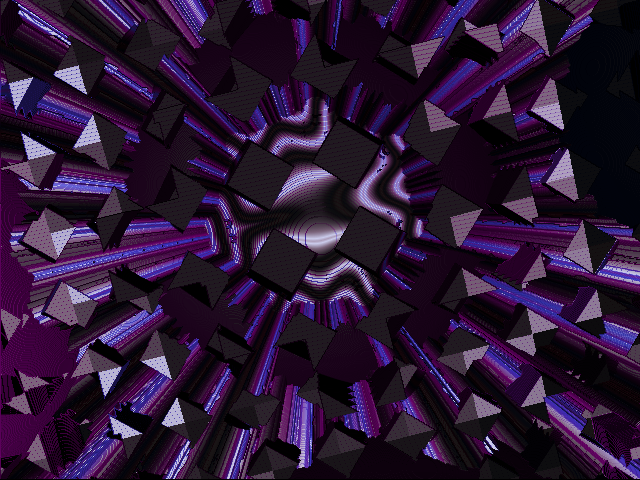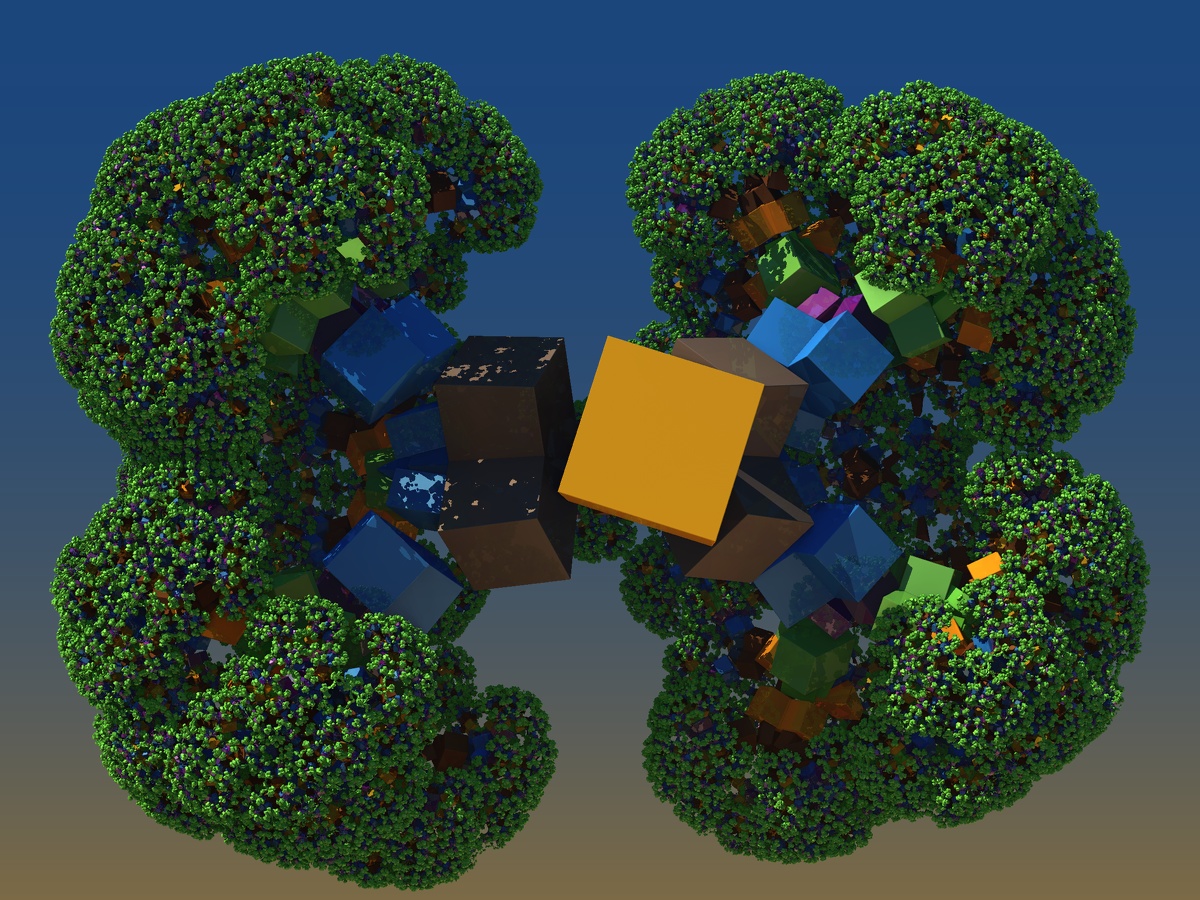Jesse
Download Section
Fractal Schemer

Posts: 1013
|
 |
« on: June 08, 2011, 11:23:02 PM » |
|
Beside the existing escapetime IFS in m3d, i want to include a new class of IFS that differs in the function.
Is there a unique name for this type what i try to explain as following:
You make some direct distance calcs, for example a sphere has the distance Sqrt(x*x+y*y+z*z)-radius,
a box would have the distance of max(max(fabs(x)-xhw, fabs(y)-yhw), fabs(z)-zhw).
Then you can can make the basic transformations [rotation, translation, scaling], iterate next and
min-combine the former distance with the current one that is decreased by the accumulated scaling factor.
I know i had discussed a very similar or maybe the same fractal type with David Makin, but do not remember
the name of this special IFS type.
The good thing about this type is that you can construct fractals in a more natural way.
|
|
|
|
|
 Logged
Logged
|
|
|
|
|
David Makin
|
 |
« Reply #1 on: June 09, 2011, 10:45:01 AM » |
|
AFAIK there aren't specific names for any different fractal algorithms using escape-time IFS, escape-time IFS itself was just the "obvious" name for all fractals of that type. As I recall the only references I've come across all refer back to Hart. The one place where I believe there may be formal studies of this sort of thing is the University of Calgary that specialises in L-systems and ways of visualising them as I think one of the methods used is conversion to LRIFS (convergent or escape-time): http://algorithmicbotany.org/Of course someone else here may know better. (LRIFS = Language Restricted IFS) |
|
|
|
|
 Logged
Logged
|
|
|
|
|
xenodreambuie
|
 |
« Reply #2 on: June 09, 2011, 12:01:59 PM » |
|
If I have it right, that's equivalent to orbit traps in IFS for escape time methods. For inverse iteration methods, it's equivalent to adding base shapes (Incendia), or constructors (XenoDream). I agree that it's the most natural way to construct fractals. I don't know of any special name for the method.
|
|
|
|
|
 Logged
Logged
|
|
|
|
Jesse
Download Section
Fractal Schemer

Posts: 1013
|
 |
« Reply #3 on: June 09, 2011, 05:14:46 PM » |
|
Thanks so far for the answers, i guess i have to invest more time for testing and finding the right approach for implementing formulas that are making sense.
Makin, there are lot of documents to explore, just bad that my math is restricted, if this would be something new i should call them MRIFS (math restricted..).
Xenodreambuie, you are right since it is adding shapes in each iteration. But without constructors or more complex base shapes it would be not very extendable, i fear. But i am just beginning to explore...
|
|
|
|
|
Tabasco Raremaster
Iterator

Posts: 172

|
 |
« Reply #4 on: June 09, 2011, 08:50:21 PM » |
|
How odd, although it might be something completely different ,when adding Global Dithering as transformation formula to Quaternions in ChaosPro , the basic shapes like spheres & cubes etc. gave some nice results that looked simular to the ones in the image. Later I tried it on a Mandelbox to give Luca some examples and the transformation works well with a box too. Not sure if he had time to work it out already.  quaternion + global dithering(circle)  mandelbox + global dithering (diamond) |
|
|
|
|
 Logged
Logged
|
|
|
|
Jesse
Download Section
Fractal Schemer

Posts: 1013
|
 |
« Reply #5 on: June 09, 2011, 11:27:26 PM » |
|
Do you have a clue how "global dithering" works? Maybe i should have made this type compatible with the common escapetime formulas, hmm. After some tries, i finally made something that looks quite similar to the escapetimes i used before: (with different rotations you could also made more close structures, but i liked it this way  )  |
|
|
|
|
 Logged
Logged
|
|
|
|
Tabasco Raremaster
Iterator

Posts: 172

|
 |
« Reply #6 on: June 10, 2011, 12:21:21 AM » |
|
Not sure how it works Jesse only that it adds certain shapes that mix with the used formula.It allows modifying the size of the shape and the frequenty.
Going to do some research right away.
btw. that`s some freaking awesome brocolli man.
|
|
|
|
|
 Logged
Logged
|
|
|
|
|
David Makin
|
 |
« Reply #7 on: June 10, 2011, 03:26:31 AM » |
|
Makin, there are lot of documents to explore, just bad that my math is restricted, if this would be something new i should call them MRIFS (math restricted..).
Even a computer program is essentially an LRIFS (or MRIFS if you count programming as maths), though generally you'd have to call them LRIIFS - Language Restricted Interactive IFS - and they generally involve a whole lot more transforms than a standard IFS  Of course the same probably goes for Existence itself  |
|
|
|
|
 Logged
Logged
|
|
|
|
|
David Makin
|
 |
« Reply #8 on: June 10, 2011, 03:32:12 AM » |
|
AFAIK there aren't specific names for any different fractal algorithms using escape-time IFS, escape-time IFS itself was just the "obvious" name for all fractals of that type. As I recall the only references I've come across all refer back to Hart. The one place where I believe there may be formal studies of this sort of thing is the University of Calgary that specialises in L-systems and ways of visualising them as I think one of the methods used is conversion to LRIFS (convergent or escape-time): http://algorithmicbotany.org/Of course someone else here may know better. (LRIFS = Language Restricted IFS) Ooops - I should have added that very similar algorithms to LRIFS are essentially used for CSG trees for which I think there may be a lot more formal documentation though I've never had time to look into it. |
|
|
|
|
 Logged
Logged
|
|
|
|
Jesse
Download Section
Fractal Schemer

Posts: 1013
|
 |
« Reply #9 on: June 10, 2011, 04:35:37 PM » |
|
Ooops - I should have added that very similar algorithms to LRIFS are essentially used for CSG trees for which I think there may be a lot more formal documentation though I've never had time to look into it.
CSG trees look quite like what i want to do, and a kind of grouping would be nice. It is still not that easy to figure out how transformations must be placed to do what they should. |
|
|
|
 Logged
Logged
|
|
|
|
Jesse
Download Section
Fractal Schemer

Posts: 1013
|
 |
« Reply #10 on: June 12, 2011, 12:20:07 AM » |
|
After some playing around i see some limitations for this type, it renders quite fast but it seems that natural shapes like ferns and trees are not well supported. For example when doing foldings for copying shapes, the transformation does not evolves like wanted towards next generations.(*) What leadse me to the question: What type of IFS would you prefer for generating 3d natural structures like ferns and trees? And it would be great if it produces distance estimates of any sort, so i can still use all features that already exists therefore. Thanks in advance  Edit: (*) Sorry, i should had been more patient with experimenting, with the right amount of rotations and foldings you can get some good shapes that are not cut or else deformed or deplaced. But suggestions are always welcome. |
|
|
« Last Edit: June 12, 2011, 11:19:21 PM by Jesse »
|
 Logged
Logged
|
|
|
|
|


















